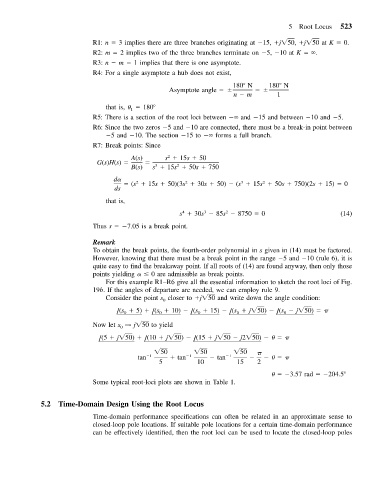Page 532 - Mechanical Engineers' Handbook (Volume 2)
P. 532
5 Root Locus 523
R1: n 3 implies there are three branches originating at 15, j 50, j 50 at K 0.
R2: m 2 implies two of the three branches terminate on 5, 10 at K .
R3: n m 1 implies that there is one asymptote.
R4: For a single asymptote a hub does not exist,
180 N 180 N
Asymptote angle
n m 1
that is, 180
1
R5: There is a section of the root loci between and 15 and between 10 and 5.
R6: Since the two zeros 5 and 10 are connected, there must be a break-in point between
5 and 10. The section 15 to forms a full branch.
R7: Break points: Since
A(s) s 15s 50
2
G(s)H(s)
2
B(s) s 15s 50s 750
3
d
2
2
2
(s 15s 50)(3s 30s 50) (s 15s 50s 750)(2s 15) 0
3
ds
that is,
2
4
3
s 30s 85s 8750 0 (14)
Thus s 7.05 is a break point.
Remark
To obtain the break points, the fourth-order polynomial in s given in (14) must be factored.
However, knowing that there must be a break point in the range 5 and 10 (rule 6), it is
quite easy to find the breakaway point. If all roots of (14) are found anyway, then only those
points yielding 0 are admissible as break points.
For this example R1–R6 give all the essential information to sketch the root loci of Fig.
19b. If the angles of departure are needed, we can employ rule 9.
Consider the point s closer to j 50 and write down the angle condition:
0
/
/
/
/ (s 5) (s 10) (s 15) (s j 50) (s j 50)
/
0
0
0
0
0
Now let s → j 50 to yield
0
/
/ (5 j 50) (10 j 50) (15 j 50 j2 50)
/
50 50 50
tan 1 tan 1 tan 1
5 10 15 2
3.57 rad 204.5
Some typical root-loci plots are shown in Table 1.
5.2 Time-Domain Design Using the Root Locus
Time-domain performance specifications can often be related in an approximate sense to
closed-loop pole locations. If suitable pole locations for a certain time-domain performance
can be effectively identified, then the root loci can be used to locate the closed-loop poles

